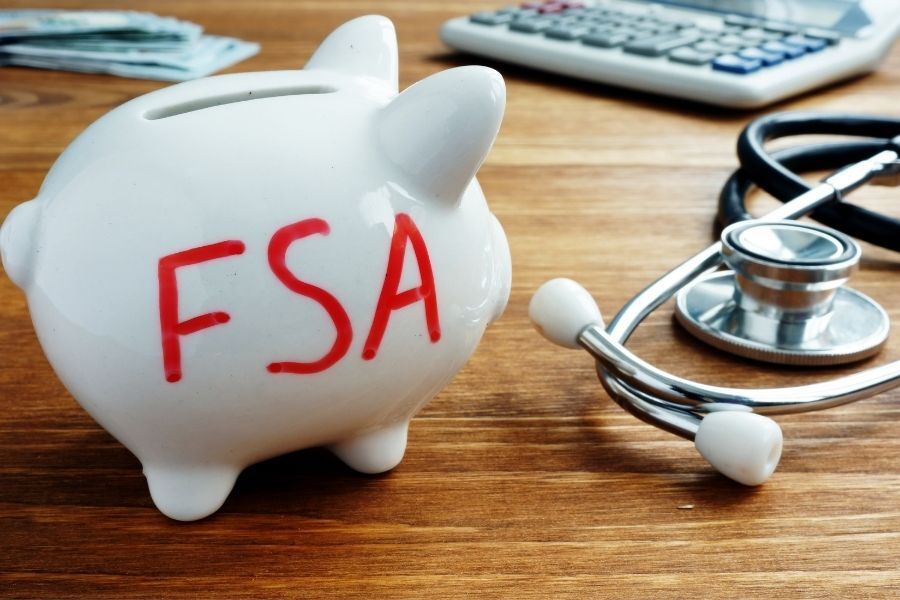
What Happens to Unused FSA Funds?
13 May 2022

Healthcare is a standard employee benefit offered by employers. Most employers also offer a Flexible Spending Account (FSA) to accompany major medical insurance plans. An FSA is a health savings account to which employees and employers can contribute funds that workers can apply towards covered out-of-pocket medical expenses.
FSA funds are deducted from an employee’s paycheck and are not subject to payroll or income taxes. As a tax-advantaged account, FSAs help employees save money on medical expenses. The different types of FSAs include a health FSA, dependent care FSA, adoption FSA, and limited-purpose FSA.
For more personalized assistance, speak with a KBI agent today.
How Much Can Employees and Employers Contribute to a Health FSA?
The Internal Revenue Service (IRS) increased the annual FSA contribution limit by $100 for 2022, making the maximum contribution amount $2,850 for an employee. If an employee is married to a spouse, the spouse can also contribute up to $2,850 to a health FSA.
Employers can contribute to a health FSA, as well. Employers can match up to $500, regardless of if the employee contributes to the health FSA. Beginning at $501, an employer can only make a dollar-for-dollar match to an employee contribution.
How Can FSA Funds Be Used?
The IRS defines what eligible medical expenses are that can be covered by FSA funds. Examples of covered medical expenses include:
- Medical supplies
- Co-pays
- Deductibles
- Diagnostic devices
- First aid kits
- Eye exams
- Hearing aids
- Some OTC medications prescribed by a physician
- Prescription medications
- Insulin and blood sugar test kits
- Thermometers
- Bandages
- Acupuncture
- Chiropractic care
- Substance abuse inpatient treatment
- Ambulance services
- Artificial limbs
- Braille books and magazines
- Breast pumps and supplies
- Dental treatment
- Eye surgery
- Birth control
- Mental health counseling
- Service animals, including grooming costs and food
- Transportation to and from medical services
- Christian Science practitioner
- Electronic body scan
- Capital expenses for medically related addition to home
- Special home fees for intellectually and developmentally disabled
- Laboratory fees
Can Dependent Care Expenses be Reimbursed?
Yes, qualifying dependent care expenses incurred by the employee are eligible for reimbursement with FSA funds. Similar types of expenses can be reimbursed as outlined in the previous section.
Why Do FSA Funds Go Unused?
FSA funds go unused when employees don’t incur enough expenses that align with the amount they contributed to their FSA. Funds might also go unused when employees don’t submit receipts in time for the end-of-year deadline for reimbursement. Poor planning is another reason FSA funds go unused—if an employee overestimates the amount of funds they’ll need to cover expected medical expenses for the year, it results in having an FSA balance at year-end.
Some employees don’t realize they can use FSA funds for qualifying expenses such as medical supplies, like thermometers and bandages, which could help them deplete their account. With that said, however, employees can’t use FSA funds to stockpile supplies—they can only purchase what would typically be used within the plan year.
What Happens to Unused FSA Funds?
The IRS provides employers with two options to offer employees for unused FSA funds. The employer can provide a two-and-a-half-month grace period during which the employee can use the funds and get reimbursed for qualifying medical expenses. The second option is to allow the employee to roll over up to $570 of unused funds into the following plan year without limiting their contribution level for that plan year. The latter option can have implications for an employer that offers a high deductible health plan (HDHP) with a health savings account (HSA) since carryover FSA funds limit HSA contributions.
An employer can offer the carryover option or the grace period but not both. With the carryover option, an employee that has $1450 remaining in their FSA at the end of the plan year can carry over $550 and will forfeit the remaining $900. With the grace period option, the employee would have two and a half months following the end of the plan year to use the $1450. Whatever is not used within the grace period would be forfeited.
Employers can choose to keep unused FSA funds. They can also choose to apply the forfeited funds to administrative costs from the plan year or credit the leftover FSA funds to employees’ FSAs the following year, as long as Internal Revenue Code Section 125 is not violated and the credit has nothing to do with employees’ claims experiences.
Feeling Overwhelmed?
Learn How a KBI Expert Can Help You Reduce Costs & Save Money!
What Are Pandemic Relief Grace Periods and Legislation?
As part of COVID-19 relief, FSA funds were provided carryover options and extensions, as outlined in the Consolidated Appropriations Act, 2021 which was signed into law at the end of 2020, and IRS Notice 2021-15 which was issued in February 2021. As summarized by the Society for Human Resource Management (SHRM), the stated legislation addressed how employers could:
- Allow participants in health care or dependent care FSAs to carry over unused balances from a plan year ending in 2020 to a plan year ending in 2021, and to carry over unused balances from a plan year ending in 2021 to a plan year ending in 2022. In other words, employees could roll over 100% of their FSA unused funds. An employer could choose to provide either, or neither, of these carryover extensions.
- Extend the 2.5 months grace period to 12 months for spending unused FSA funds for plan years ending in 2020 or 2021.
- Allow departing employees and employees who stopped participating in a health FSA plan during 2020 or 2021 to continue to be reimbursed from unused balances through the end of the plan year in which their participation ended, including any extended grace periods.
These extensions and changes only go through the end of 2022.
Are There Different Rules for Dependent Care FSA Funds?
A dependent care FSA is a tax-advantaged account to help workers pay for a dependent’s covered out-of-pocket medical expenses. Under normal circumstances, the rollover and grace period revisions only apply to health FSA plans. However, COVID-10 relief legislation allowed employers to opt to extend dependent care FSA claims for a dependent that “aged out” of qualifying for reimbursement due to turning 13. The age was temporarily raised to 14 for dependent care FSA funds that went unspent at the end of the 2020 plan year.
The total contribution amount for those married filing jointly is $5,000 and for those married filing separately, it’s $2,500. However, as part of COVID-19 relief, the $2,500 limit was raised to $5,250 for married couples filing separately through 2022.
Adoption FSAs are also available, so prospective parents can set pre-tax dollars aside to help pay for expenses associated with adopting a child. Limited purpose FSAs can accompany an HSA and only cover dental and vision expenses.
How Can Employees Be Sure to Use their FSA Funds?
To support employees in using their FSA funds, employers can remind employees that the list of reimbursable expenses is robust. The IRS publishes an extensive list of qualifying FSA expenses annually.
Employees can also look at their medical expenses for the last few years, as well as the total amount used in their previous year's FSAs, and use those amounts as a benchmark for how much to contribute for the next plan year.
How Do Employees Enroll in FSAs and Get Reimbursed?
Employees can join their employer’s FSA during open enrollment, at the time an employer offers a new FSA, as a newly hired employee, and during a qualifying life event, such as a marriage or birth of a child. At the time of enrollment, the employee has to choose how much they want to contribute for the year, and that amount is averaged out based on the number of pay periods in the year. The funds are then deducted from the employee’s paycheck.
An employee can “borrow” against funds that are not yet contributed to the FSA if they need to pay for a qualifying expense. For example, let’s say you contributed $2000 for the plan year to your FSA, and so far, $1000 has been taken from your paychecks. You then have a medical expense of $1,500. You will be able to use your FSA funds to cover that $1,500, even though that total amount has not yet been withdrawn from your pay.
If an employee is terminated prior to completing their FSA contribution and they’ve used funds that are more than they contributed, the company is left eating the expense.
Once the employee is enrolled, they can pay out of pocket and then submit receipts for reimbursement or use an FSA debit card, after which, receipts still need to be submitted to verify purchases.
KBI Can Help You Select and Manage an FSA
Benefits of offering an FSA include providing a comprehensive benefits package to attract and retain employees, reducing employers’ contribution to FICA and payroll taxes, and writing off some of the plan’s administrative costs for the business.
KBI’s team of brokers can work with your organization to determine the best FSA options for your business. We can also assist in determining if the FSA year-end rollover or grace period options are best for your workforce—or maybe it’s neither.
Other employee benefits we specialize in include medical, worker’s compensation, disability, dental, vision, and more, so we can serve as your one-stop shop for employee benefits design, implementation, and assessment. We’re here to forge a relationship with you for the long-term as your trusted employee benefits brokerage firm.



